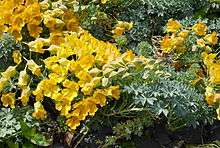Tropaeolum polyphyllum
Tropaeolum polyphyllum is a species of perennial plant in the Tropaeolaceae family. It is endemic to mountainous regions of Chile and Argentina where it is called in Spanish soldadito grande de la cordillera (great soldier of the mountains).
| Tropaeolum polyphyllum | |
|---|---|
.jpg) | |
| Scientific classification | |
| Kingdom: | Plantae |
| Clade: | Tracheophytes |
| Clade: | Angiosperms |
| Clade: | Eudicots |
| Clade: | Rosids |
| Order: | Brassicales |
| Family: | Tropaeolaceae |
| Genus: | Tropaeolum |
| Species: | T. polyphyllum |
| Binomial name | |
| Tropaeolum polyphyllum Cav. | |

Description
Tropaeolum polyphyllum is a herbaceous perennial, overwintering as a tuber deep in the soil. It sends out long rhizomes from which shoots develop which trail over the ground. These are densely covered with silvery green, deeply lobed leaves. The flower buds have inflated pale green calyces and the sepals are extended backwards into a short spur. The relatively large and showy flowers are borne on long slender stalks and are golden yellow. After flowering, which takes place in mid-summer, the shoots die back and the plant remains dormant until the following year.[1]
Distribution and habitat
Tropaeolum polyphyllum is endemic to the central Andes in Chile and Argentina where it grows at heights of up to 3,000 metres (9,800 ft) above sea level. Its typical habitat is among scantily vegetated stony ground or on scree where it forms small hummocks of grey-green foliage studded with yellow flowers.[2] In this area, summer droughts may last for several months and what precipitation there is, falls mainly in the winter.[3] The plant has small, rounded tubers which are buried deep in the ground and which enable it to survive being covered with snow for several months and withstand temperatures down to −20 °C (−4 °F).[3]
Cultivation
Tropaeolum polyphyllum needs full sun and neutral or slightly acid, well drained soil. It grows well on hot, dry banks and is hardy when fully established. Propagate from tubers or by seed. The seeds should be sown in the spring in well-drained compost and covered with 1 to 2 cm (0.4 to 0.8 in) of sand. The containers should be kept at below 4 °C (39 °F) until the seedlings appear in about a month. Too high a temperature inhibits germination.[4] The USDA Hardiness Zone is 7.[3]
References
- Perry, Frances (1972). Flowers of the World. The Hamlyn Publishing Group Ltd. p. 300. ISBN 060001634X.
- "Tropaeolum polyphyllum". Rareplants.co.uk. Retrieved 2012-06-23.
- Michail Belov (2005–2009). "Tropaeolum polyphyllum". ChileFlora. Retrieved 2012-06-23.
- "Tropaeolum". Pacific Bulb Society. Retrieved 2012-06-23.
| Wikimedia Commons has media related to Tropaeolum polyphyllum. |